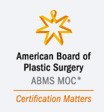

Breast augmentations have skyrocketed by 37% since 2000 according to the 2016 report released by the American Society of Plastic Surgeons (ASPS). With the popularity of this procedure plastic surgeons are seeing a rise in breast revision surgeries. If you are considering a revision surgery, here is more in-depth information to know before undergoing the procedure.
What is a Breast Revision
A breast revision surgery is performed to change the size of implants and/or to correct issues from the original breast surgery. The details of surgery depend on the type of revision required. Generally, the revisions would address the following:
- Breast implant size
- Breast implant rupture
- Breast implant rippling
- Breast implant placement
- Capsular contracture
- Double bubble deformity
- Nipple or aerola positioning
- Implant removal
Who Should Consider Revision?
Patients who are dissatisfied with their original breast implant surgery or who are experiencing complications may consider undergoing a revision. As breasts can change over time due to age, gravity and other factors, it is also not uncommon for patients who were happy with the original breast augmentation to want to undergo a revision surgery.
Ideal candidates should:
- Have a reason to change their current implants
- Not be pregnant or nursing
- Be in good overall health
- Be at or close to ideal weight
- Be a non-smoker
Revision Wait Time
As the breasts will need time to “settle” into natural positions after cosmetic surgery in order to see the final results, it is advised that a patient waits before undergoing revision surgery. The average length of time usually is about 1 year. While it’s natural in some cases to consider revision early on, most plastic surgeons will recommend waiting 4-6 months before even discussing a revision procedure.
Post-Surgery
For optimal outcome, it is important for a patient to follow the surgeon’s post-surgery care instructions. The surgeon will provide specific details that will help with recovery. Most patients will feel tired and sore after surgery, which usually is about a couple of days. Many patients are able to return to work within one week. Within the next few weeks residual swelling and sensitivity will continue to diminish. It’s important to refrain from strenuous physical activities while you heal.
Risks and complications are typically uncommon and minimal. Some of the issues that may arise are capsular contracture, implant rupture, and infection. Thus, it is important to follow-up with your surgeon after the surgery and continue regular monitoring of the implants.
Selecting a Surgeon
Before you decide on who will perform your surgery, do your homework by consulting with several board certified plastic surgeons. You should select your surgeon based on education, credentials, training, experience with breast revision surgery as well as your comfort level. Review before and after photos of revision surgeries. If you are able to review photos that feature a patient who is similar to you in age and overall natural anatomy it may help you get an idea of possible results and realistic expectations.
During the consultation, you should discuss your desired outcome and treatment plan. In customizing your treatment plan, the surgeon will examine details such as your current breast shape, size and implant type, desired new shape and size, nipple and areola positioning, skin quality and elasticity, as well as breast tissue quality and quantity. After the meeting, you will have a clear understanding of the proposed procedure that determines implant type and size, location, incision and scar placements, as well as the need for a breast lift to address sagging.
Check out below for further reading:
Breast Surgeries: Achieving Desired Results
How to Check Plastic Surgeon Credentials















